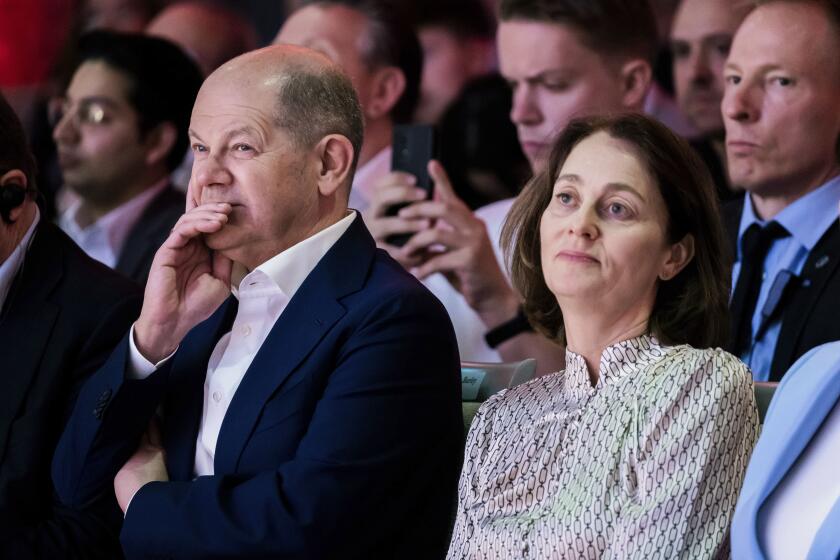THE AMERICA’S CUP : Notebook : Fay’s Sails Carry No Pinstripes
When Fay, Richwhite and Company Ltd. of Auckland, New Zealand, is mentioned around here, everyone knows who Fay is.
But Michael Fay’s silent partner, David Richwhite, surfaced Tuesday to explain his side of the America’s Cup operation, which is totally funded by their merchant banking firm.
“I’ve stuck to minding the bank and Michael’s stuck to yachting,” Richwhite said.
Richwhite said he has no objections to the arrangement.
“I’m not a sailor,” he said. “Michael has the tough job. When we got into this, we were new to the world of yachting and up against some pretty old hands.”
Richwhite recalled walking into their office together in September of 1983, after watching Alan Bond’s Australia II win the Cup on television.
“It was, ‘Boy, did you see that?’ And then we thought, ‘Well, now that it’s in Perth, we should have a shot at that.’ ”
So far, Richwhite calculated, their shot has cost them $20 million New Zealand dollars--about $12-14 million U.S., give or take a million, he said.
That includes legal fees, on which the meter is running.
They had major sponsors for the last campaign.
“But this time Michael and I decided to do it ourselves,” Richwhite said. “It’s a simple matter of writing out a check.”
Fay will be aboard the boat for the races, but Richwhite will watch from a spectator vessel.
“The boys asked me to go on board,” Richwhite said. “It would have been fantastic, but a lot of boys have worked very hard for the chance. It wouldn’t be right to step out of a pinstripe suit onto the boat.”
Amid conflicting reports of support back home, Richwhite said, “There still is some interest there, but it’s latent. They believe it’s a mismatch and they believe it’s unfair.
“But if we took the first race, I think you’d see New Zealand return to the fever pitch we had at Fremantle.”
Tom Whidden, Dennis Conner’s tactician, indicates that Stars & Stripes will be somewhat aggressive today.
When Conner won the coin toss Tuesday to determine from which end of the line the boats will start pre-race maneuvers, he picked the starboard (right) end, meaning he’ll have right of way when the boats come together.
“His plan is never to stay away from duking it out with the other guy,” Whidden said. “I think Dennis is as aggressive as he’s ever been, and we’ve gotten better about making the boat maneuver. We’re not going to stay away.”
New Zealand objects that Conner’s catamaran is so much faster than its monohull that he can get away with a foul because of the 720 rule being used for the first time in an America’s Cup. A boat committing a foul can absolve itself by turning two full circles--720 degrees--rather than risk a protest hearing in which it could be disqualified.
Kiwi skipper David Barnes said: “We don’t feel it is a penalty for a faster boat. Stars & Stripes could do a 720 in about two minutes or less and be back up with us in a mile or two.”
Whidden said, “The 720 has nothing to do other than try to make this a better event. With only two out of three races, if one boat made a minor foul in the middle of a 20-mile windward-leeward leg, it would be too bad to just have the boat disqualified and out of the race.
“We haven’t tried it yet. We don’t go out and actually practice circles, but we have a rough idea. It would take us about a minute, maybe two.”
Conner will be wearing a replica of the Maori sea god Tangaroa around his neck today.
The carving was presented by Rawiri Pukepuke Ahitapu, who said he was fired from his job with the New Zealand government-run tourist board when he agreed to make one for Conner.
Supposedly, Rawiri also made one that the New Zealand 12-meter carried in ’87 until Fay had it removed before the final race against Stars & Stripes, which, of course, the Kiwis lost.
Conner was quoted as saying: “I’m delighted to have the Tangaroa with me during the race. I’m sure that it will help us to sail faster and protect us from the big boat.”
New Zealand sail designer Tom Schnackenberg offered an explanation as to why the big boat hasn’t come up to the expectations of Stars & Stripes.
“The difference in performance between the original predictions and what we’ve observed has been attributed to inadequacies in the program,” he said.
“As it’s leveled off, we’ve settled down so we know enough about sail coefficients in particular.”
Sorry you asked?
Schnackenberg also explained why a multihull is inherently faster than a monohull--”of the same size,” Conner interjected, implying that his boat is only half the size of KZ-1.
The main difference is that the Kiwi monohull is dragging lead weight around for ballast, whereas the multihull has no ballast, achieving its stability from its wide footprint design.
“In the normal ratio of force to drag and power to weight, the monohull loses out,” Schnackenberg said.
More to Read
Start your day right
Sign up for Essential California for news, features and recommendations from the L.A. Times and beyond in your inbox six days a week.
You may occasionally receive promotional content from the Los Angeles Times.






